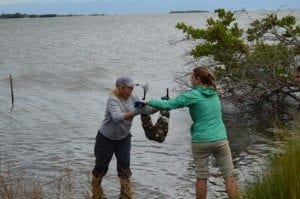UCF Biologist and Oysters Help Restore Indian River Lagoon
 The tiny, mushy mollusks usually slurped up at local bars and restaurants may be the eco-friendly heroes that end up saving Brevard County’s Indian River Lagoon.
The tiny, mushy mollusks usually slurped up at local bars and restaurants may be the eco-friendly heroes that end up saving Brevard County’s Indian River Lagoon.
Knee-deep in murky water for several hours last week, community volunteers, Brevard County Natural Resources employees, Brevard Zoo employees and University of Central Florida students worked alongside UCF biologist and professor Linda Walters deploying “gardened” oysters into the lagoon with hopes they will take root and help clean the waterway.
Amid periods of rain and sunshine, the teams deployed hundreds of oysters in pilot reefs along key sections of the lagoon in Melbourne Beach, Port St. John and Merritt Island. The UCF biology students and Walters will monitor the growth and health of the oysters to see if they flourish and start filtering the lagoon’s water. Oysters can clean up to 50 gallons a day for their 20-year life span with no ill side effects. If the experiment works, they could end up being the answer to the pollution that’s hit the lagoon in the past few years.
The lagoon runs for 156 miles through five counties including Volusia and Brevard and has an estimated economic impact of $3.7 billion per year. But the Brevard portion of the lagoon – which includes the Indian and Banana rivers – has seen a severe spike in pollution, which reeks and has been linked to allergic reactions among some nearby residents. The pollution also creates multiple algae blooms each year that kill fish and potentially the other creatures that eat the contaminated fish.
Walters has been studying intertidal oysters and their role in the natural ecosystem for the past 17 years in Volusia County in the Mosquito Lagoon – the northern portion of the Indian River Lagoon system. With the help of the Brevard Zoo, she and a team of more than 40,000 volunteers have established 68 oyster reefs in Mosquito Lagoon since 2007, providing substrate for more than 6.9 million oysters. In Canaveral National Seashore waters, these restored reefs now boast more than 700 live oysters per square meter. The location of all restored reefs were set on the historic footprints of reefs lost within the past 50 years because of boat and wind wakes dislodging the oysters and pushing them out of the intertidal zone.
To see what was possible in Brevard County, where the number of historic oyster reefs is very limited, Walters teamed up with Brevard County Natural Resources and Brevard Zoo. With $500,000 from the state, the team is tackling three issues: whether the oysters will grow in the lagoon, whether those oysters can be used to create oyster reefs in the lagoon, and finally, an analysis of how successful the oysters are at removing nitrogen and phosphorus from the water.
Oyster gardening began in January in Brevard County when the zoo began offering two-hour workshops. Volunteers were shown everything they needed to grow the baby colonies under docks.
Last week was the first time the volunteers delivered their fully grown oysters for planting in key areas along the Indian River Lagoon. The results thus far of the gardening project were positive. There were many more adult oysters than the organizers expected. Volunteers enjoyed good-natured competitions for largest oysters (4.7 inches), most oysters (gardeners from Malabar), and all sorts of questions and comments about the associated biodiversity. The volunteer gardeners talked about what they encountered raising their oysters, such as barnacles, crabs and shrimp.
The zoo will continue to offer oyster gardening workshops as part of the project with hopes of having 1,000 gardeners preparing oysters for introduction into the lagoon by the end of 2015.
“The zoo’s mission is wildlife conservation through education and participation and this project perfectly embodies that mission. We are educating Brevard County residents about the importance of oysters to our lagoon and are empowering them to join us in our conservations efforts to save the lagoon,” said Sammy Anderson, lagoon restoration specialist at the zoo.
Despite success in the Mosquito Lagoon, this project is not a sure bet.
“A primary focus is testing if we can build oyster reefs in locations where there is no historical footprint of oysters,” Walters said. “That’s our role in this project. It’s very exciting.”
Walters and her students will monitor the oysters for weight gain, growth and survival, as well as salinity, water temperate and other indicators through March. Depending on the results, the experiment may be expanded to others parts of the lagoon.
To read the original article please visit UCF Today.
